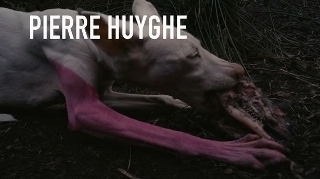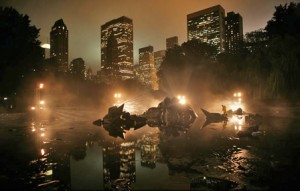PIERRE IN WONDERLAND
At the entrance to Pierre Huyghe’s retrospective at LACMA, a tuxedoed gentleman requested my name and then announced me to the exhibit as if I was entering a grand ball (Name Announcer, 2011). I was then greeted by a low-lit maze of angled and mostly stark white walls which led me down a rabbit hole of seemingly unrelated curiosities: A super-8mm film of home-movie quality (Á Part, 1986-87); a poster showing a forked road (Or, 1995); type-written pages which seemed to be interpreting the galleries before me (L’Écrivain public, 1995); a montage of 12 color photographic prints—C-prints—that looked like vacation pictures (Extended Holidays, 1996); and—I’m not kidding—live ants that crawled out from their own nests inside the walls, and easily missed spiders that hang out in a corner (Umwelt, 2011).
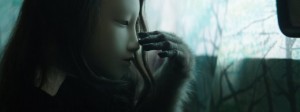 The Paris-born Huyghe (pronounced WEEG) has been a multidisciplinary artist for 25 years, but his name is no doubt peripheral—if known at all—to most Angelinos. Having redefined art and the way it is exhibited, the 52-year-old has become a major figure in the French and international art scene, but standing in a room with a giant Atari Pong game over my head, and a tank inhabited by a sculpture and a hermit crab, I began to think that this was so much pretentious hogwash and I wouldn’t last more than five minutes.
The Paris-born Huyghe (pronounced WEEG) has been a multidisciplinary artist for 25 years, but his name is no doubt peripheral—if known at all—to most Angelinos. Having redefined art and the way it is exhibited, the 52-year-old has become a major figure in the French and international art scene, but standing in a room with a giant Atari Pong game over my head, and a tank inhabited by a sculpture and a hermit crab, I began to think that this was so much pretentious hogwash and I wouldn’t last more than five minutes.
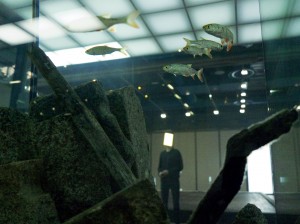 My ennui turned to curiosity and excitement, and had the exhibit not closed over four hours later, I never would have left. Indeed, with over 50 works, many being presented for the first time in the U.S., this fascinating look into the mind of a boundary-stretching artist warrants repeat visits. Don’t come expecting his work to be filled with eye-popping theatricality or beauty (although you will find drama and splendor at the most unexpected moments). Don’t look for descriptions on the walls (there aren’t any). And I dare say you should avoid reading about the creator’s intentions and the explications from hifalutin art critics (I have scanned them, and most read like the kind of legalistic jargon which leaves you scratching your head in bewilderment).
My ennui turned to curiosity and excitement, and had the exhibit not closed over four hours later, I never would have left. Indeed, with over 50 works, many being presented for the first time in the U.S., this fascinating look into the mind of a boundary-stretching artist warrants repeat visits. Don’t come expecting his work to be filled with eye-popping theatricality or beauty (although you will find drama and splendor at the most unexpected moments). Don’t look for descriptions on the walls (there aren’t any). And I dare say you should avoid reading about the creator’s intentions and the explications from hifalutin art critics (I have scanned them, and most read like the kind of legalistic jargon which leaves you scratching your head in bewilderment).
Your experience will differ from mine; subjectivity is rampant here, and there is no wrong experience. Don’t be dismayed if you find some works baffling and opaque, just go with the flow; it’s OK (and perhaps intentional) that you explore without interpreting. One of the exhibits is a human player, who you may find reading a book or roaming around with an LED-lit mask. I had a terrific conversation with the lad, Andre, about some of the pieces. He allowed me to come to my own conclusions by sweeping his hand over a living ice rink (L’Expédition scintillante, Acte 3 (Black 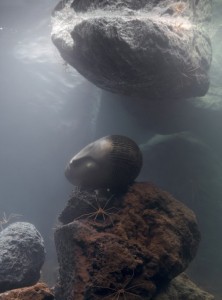 Ice Rink), 2002), and saying “It is what it is.” (It is interesting to note here that this rink has taken different forms in the exhibit’s previous showings at the Centre Georges Pompidou in Paris and the Museum Ludwig in Cologne, while some gallery walls remain intact.)
Ice Rink), 2002), and saying “It is what it is.” (It is interesting to note here that this rink has taken different forms in the exhibit’s previous showings at the Centre Georges Pompidou in Paris and the Museum Ludwig in Cologne, while some gallery walls remain intact.)
It’s almost like being on a scavenger hunt, looking for hidden messages. Indeed, while two patrons played the interface computer game (Atari Light, 1999), the pixilated ceiling lights illuminated an old book on a bench. Did someone leave it behind? Is it art? Can it be touched? Hell, I thought. I’m here to play. I picked up an English-language copy of Joris-Karl Huysmans’ À rebours, translated here as Against the Grain (it has also been published as Against Nature). This scandalous 1884 French novel, which describes an aesthete’s “alluring liaison” with a “cherry-lipped youth,” gained notoriety as an exhibit in the trials of Oscar Wilde in 1895: The prosecutor referred to it as a “sodomitical” book. Whether Huyghe was telling me that he’s gay, that naturalism is antiquated, that we are destroying the earth, or all or none of these, the subtitle spoke volumes about this retrospective: “A Novel Without a Plot.”
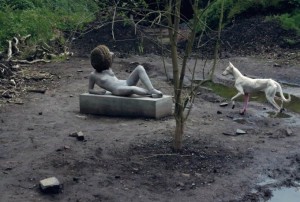 Yet as you explore, you will notice through-lines: I lost sense of time and space while watching a 12-minute film, A Way in Untilled (2012). It took place (I found out later) around a former compost heap in a park. Scavenging around the site, which has an enormous marijuana plant and a statue of a female nude with a working apiary on her head, was a white Ibizan Hound with a colored leg. Halfway through the film, the same animal with a pink leg (dyed with food coloring) appeared next to me. Huyghe’s rescued dog, named Human, roams about the exhibit, and actually seemed to cogitate over my request for an autograph (please do not approach the dog). Later, as the gallery widens, you will find the statue from the film outside with live bees working on a honeycomb (Untilled (Liegender Frauenakt) [Nude woman reclining], 2012), while up above three weather-making machines produce snow, rain, and fog (L’Expédition scintillante, Acte 1 (weather score), 2002).
Yet as you explore, you will notice through-lines: I lost sense of time and space while watching a 12-minute film, A Way in Untilled (2012). It took place (I found out later) around a former compost heap in a park. Scavenging around the site, which has an enormous marijuana plant and a statue of a female nude with a working apiary on her head, was a white Ibizan Hound with a colored leg. Halfway through the film, the same animal with a pink leg (dyed with food coloring) appeared next to me. Huyghe’s rescued dog, named Human, roams about the exhibit, and actually seemed to cogitate over my request for an autograph (please do not approach the dog). Later, as the gallery widens, you will find the statue from the film outside with live bees working on a honeycomb (Untilled (Liegender Frauenakt) [Nude woman reclining], 2012), while up above three weather-making machines produce snow, rain, and fog (L’Expédition scintillante, Acte 1 (weather score), 2002).
The apotheosis occurred for me while watching the nearly 22-minute film A Journey That Wasn’t (2005), playing in its own room where a light mist caught the rays of the projection. This cinematic masterpiece shifts between an Antarctic expedition involving penguins and a live orchestra in Central Park. An amalgam of two Huyghe projects, this uncategorizable film—Documentary? Sci-fi? Adventure? Musical?—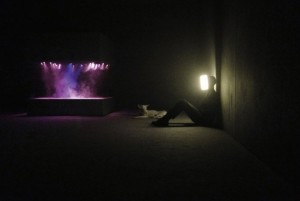 had me riveted (you can learn about its genesis later in this recommended article in the National Gallery of Canada Magazine).
had me riveted (you can learn about its genesis later in this recommended article in the National Gallery of Canada Magazine).
I wondered if the museum patrons who blew in and out of the room missed a glorious experience because they were too concentrated on finding a literal plot. At film’s end, a fog-making box that looked like a mini rock-concert stage pulsed with colored lights while Debussy’s gorgeous orchestral version of Erik Satie’s Gymnopédies hovered throughout the dark room (L’Expédition scintillante, Acte 2 (Light Box), 2002). I felt rejuvenated hanging out in this arena that vacillated between the familiar and the unknown.
It’s tempting to discuss dozens of works, but it seems almost specious to elucidate anything for which you may have a completely different experience. This isn’t about individual works; the non-chronological format here creates a space that is quite literally a living being with its own rhythm. Interact with these pieces just as they are interacting with each other.
photos by Pierre Huyghe, Arash Nassiri, Ola Rinda, and Guillaume Ziccarelli
Pierre Huyghe
Los Angeles County Museum of Art
organized by the Musée National d’Art Moderne, Paris
5905 Wilshire Blvd
on view through February 22, 2015 (closed Wednesdays)
for tickets, call 310.247.3049 or visit www.lacma.org
